2009 TOYOTA SIENNA warning
[x] Cancel search: warningPage 515 of 592

5
When trouble arises
515
5-2. Steps to take in an emergency
If you have a flat tire (vehicles with run-flat tires)
■In some condition (such as at high temperatures)
You cannot continue driving for up to 100 miles (160 km).
■If you cannot distinguish between the standard tires and run-flat
tires
Consult your Toyota dealer.
■For the detailed information on run-flat tires
See the tire warranty book.
NOTICE
■When replacing the tires
When removing or fitting the wheels, tires or the tire pressure warning
valve and transmitter, contact your Toyota dealer as the tire pressure
warning valve and transmitter may be damaged if not handled correctly.
■To avoid damaging the tire pressure warning valves and transmit-
ters
Do not use liquid sealants on flat tires.
Take your vehicle to the nearest Toyota dealer or authorized tire
dealer as soon as possible.
■ Run-flat tires (A “RFT” or “DSST” mark is molded on the
sidewall)
You can continue driving a
vehicle with run-flat tires even
if any tire goes flat.
It is able to run for a maxi-
mum of 100 miles (160 km)
at a speed below 55 mph (90
km/h) after the tire pressure
warning light comes on.
( P. 507)
Page 524 of 592
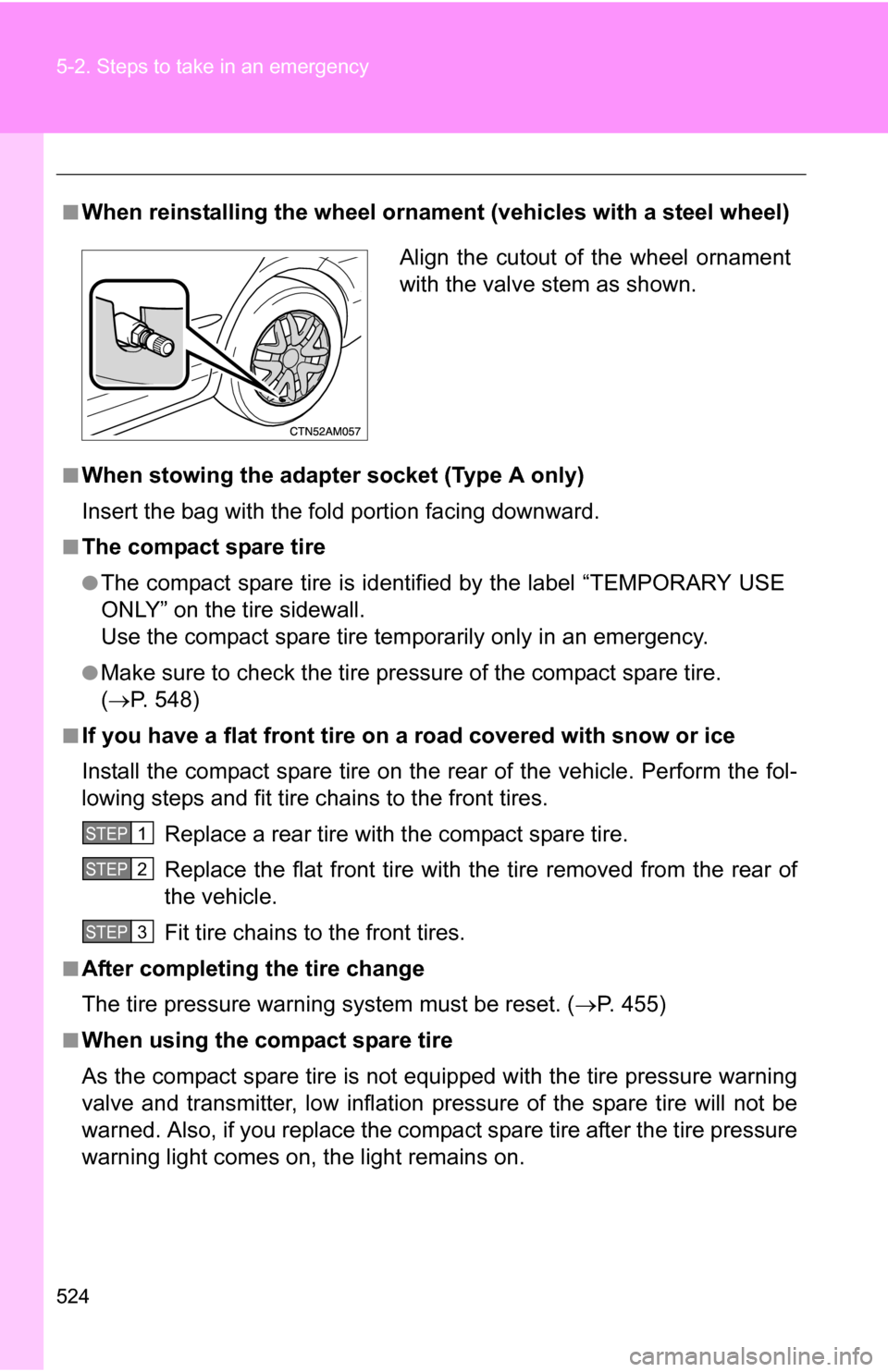
524 5-2. Steps to take in an emergency
■When reinstalling the wheel ornament (vehicles with a steel wheel)
■When stowing the adapter socket (Type A only)
Insert the bag with the fold portion facing downward.
■The compact spare tire
●The compact spare tire is identified by the label “TEMPORARY USE
ONLY” on the tire sidewall.
Use the compact spare tire temporarily only in an emergency.
●Make sure to check the tire pressure of the compact spare tire.
( P. 548)
■If you have a flat front tire on a road covered with snow or ice
Install the compact spare tire on the rear of the vehicle. Perform the fol-
lowing steps and fit tire chains to the front tires.
Replace a rear tire with the compact spare tire.
Replace the flat front tire with the tire removed from the rear of
the vehicle.
Fit tire chains to the front tires.
■After completing the tire change
The tire pressure warnin g system must be reset. ( P. 455)
■When using the compact spare tire
As the compact spare tire is not equipped with the tire pressure warning
valve and transmitter, low inflation pressure of the spare tire will not be
warned. Also, if you replace the compac t spare tire after the tire pressure
warning light comes on, the light remains on.
Align the cutout of the wheel ornament
with the valve stem as shown.
STEP1
STEP2
STEP3
Page 528 of 592
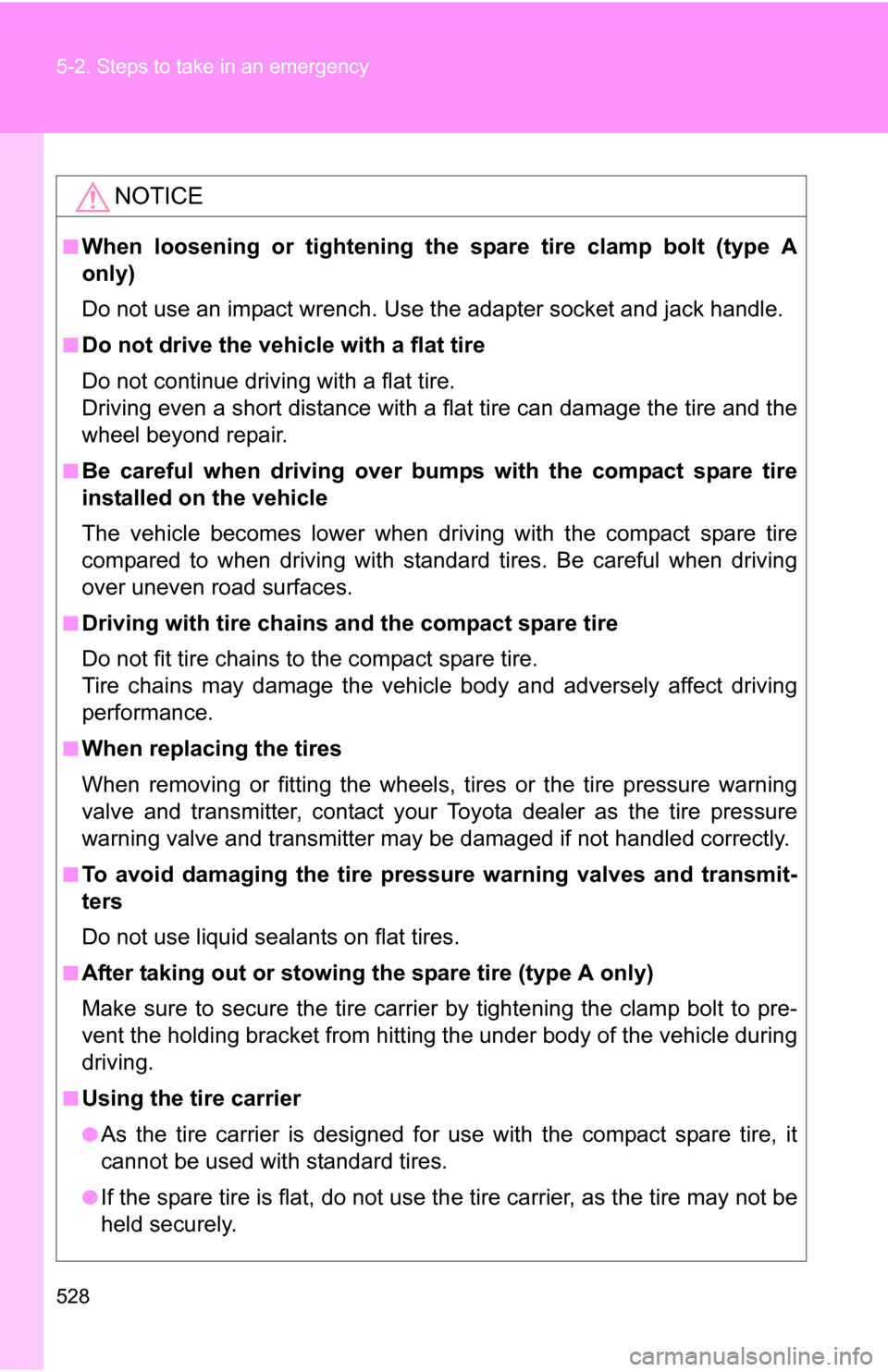
528 5-2. Steps to take in an emergency
NOTICE
■When loosening or tightening the spare tire clamp bolt (type A
only)
Do not use an impact wrench. Use the adapter socket and jack handle.
■Do not drive the vehicle with a flat tire
Do not continue driving with a flat tire.
Driving even a short distance with a flat tire can damage the tire and the
wheel beyond repair.
■Be careful when driving over bumps with the compact spare tire
installed on the vehicle
The vehicle becomes lower when driving with the compact spare tire
compared to when drivin g with standard tires. Be careful when driving
over uneven road surfaces.
■Driving with tire chains and the compact spare tire
Do not fit tire chains to the compact spare tire.
Tire chains may damage the vehicle body and adversely affect driving
performance.
■When replacing the tires
When removing or fitting the wheels, tires or the tire pressure warning
valve and transmitter, contact your Toyota dealer as the tire pressure
warning valve and transmitter may be damaged if not handled correctly.
■To avoid damaging the tire pressure warning valves and transmit-
ters
Do not use liquid sealants on flat tires.
■After taking out or stowing the spare tire (type A only)
Make sure to secure the tire carrier by tightening the clamp bolt to pre-
vent the holding bracket from hitting the under body of the vehicle during
driving.
■Using the tire carrier
●As the tire carrier is designed for use with the compact spare tire, it
cannot be used with standard tires.
●If the spare tire is flat, do not use th e tire carrier, as the tire may not be
held securely.
Page 558 of 592
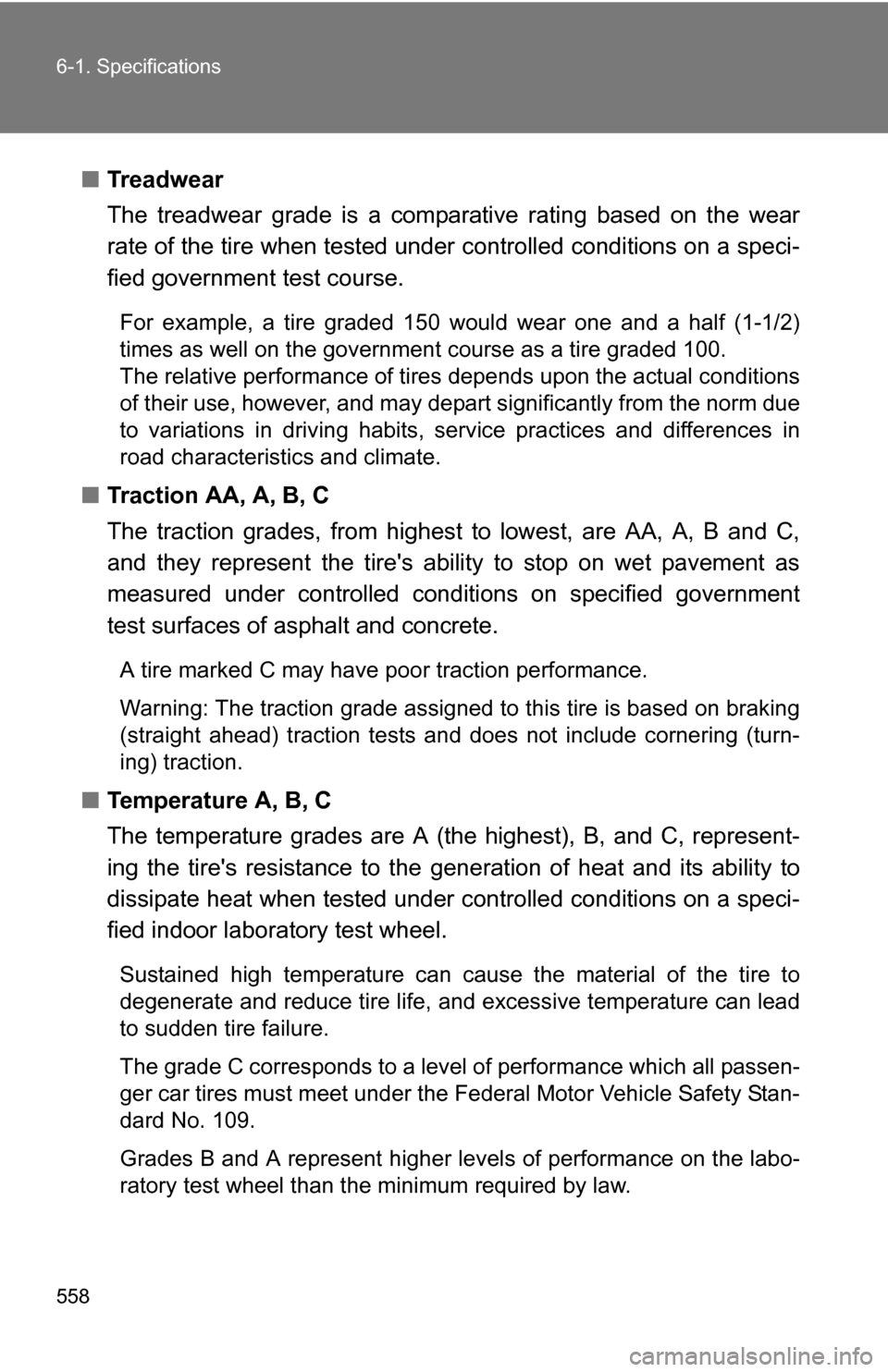
558 6-1. Specifications
■Treadwear
The treadwear grade is a comparative rating based on the wear
rate of the tire when tested under controlled conditions on a speci-
fied government test course.
For example, a tire graded 150 would wear one and a half (1-1/2)
times as well on the government course as a tire graded 100.
The relative performance of tires depends upon the actual conditions
of their use, however, and may depart significantly from the norm due
to variations in driving habits, service practices and differences in
road characteristics and climate.
■ Traction AA, A, B, C
The traction grades, from highest to lowest, are AA, A, B and C,
and they represen t the tire's ability to stop on wet pavement as
measured under controlled cond itions on specified government
test surfaces of asphalt and concrete.
A tire marked C may have poor traction performance.
Warning: The traction grade assigned to this tire is based on braking
(straight ahead) traction tests and does not include cornering (turn-
ing) traction.
■ Temperature A, B, C
The temperature grades are A (the highest), B, and C, represent-
ing the tire's resistance to the generation of heat and its ability to
dissipate heat when tested under controlled conditions on a speci-
fied indoor laboratory test wheel.
Sustained high temperature can cause the material of the tire to
degenerate and reduce tire life, and excessive temperature can lead
to sudden tire failure.
The grade C corresponds to a level of performance which all passen-
ger car tires must meet under the Federal Motor Vehicle Safety Stan-
dard No. 109.
Grades B and A represent higher levels of performance on the labo-
ratory test wheel than the minimum required by law.
Page 559 of 592

559
6-1. Specifications
6
Vehicle specifications
Warning: The temperature grades for this tire are established for a
tire that is properly inflated and not overloaded.
Excessive speed, underinflation, or
excessive loading, either sepa-
rately or in combination, can caus e heat buildup and possible tire fail-
ure.
Glossary of tire terminology
Tire related termMeaning
Cold tire inflation pres-
sure Tire pressure when the vehicle has been
parked for three hours or more, or has not
been driven more than 1 mile or 1.5 km under
that condition
Maximum inflation
pressure The maximum cold inflated
pressure to which a
tire may be inflated, s hown on the sidewall of
the tire
Recommended infla-
tion pressure Cold tire inflation pressure recommended by a
manufacturer
Accessory weight The combined weight (in excess of those stan-
dard items which may be replaced) of auto-
matic transmission, power steering, power
brakes, power windows, power seats, radio
and heater, to the extent that these items are
available as factory-installed equipment
(whether installed or not)
Curb weight The weight of a motor vehicle with standard
equipment, including the maximum capacity of
fuel, oil and coolant, and if so equipped, air
conditioning and additional weight optional
engine
Maximum loaded vehi-
cle weight The sum of:
(a) Curb weight
(b) Accessory weight
(c) Vehicle capacity weight
(d) Production options weight
Page 568 of 592
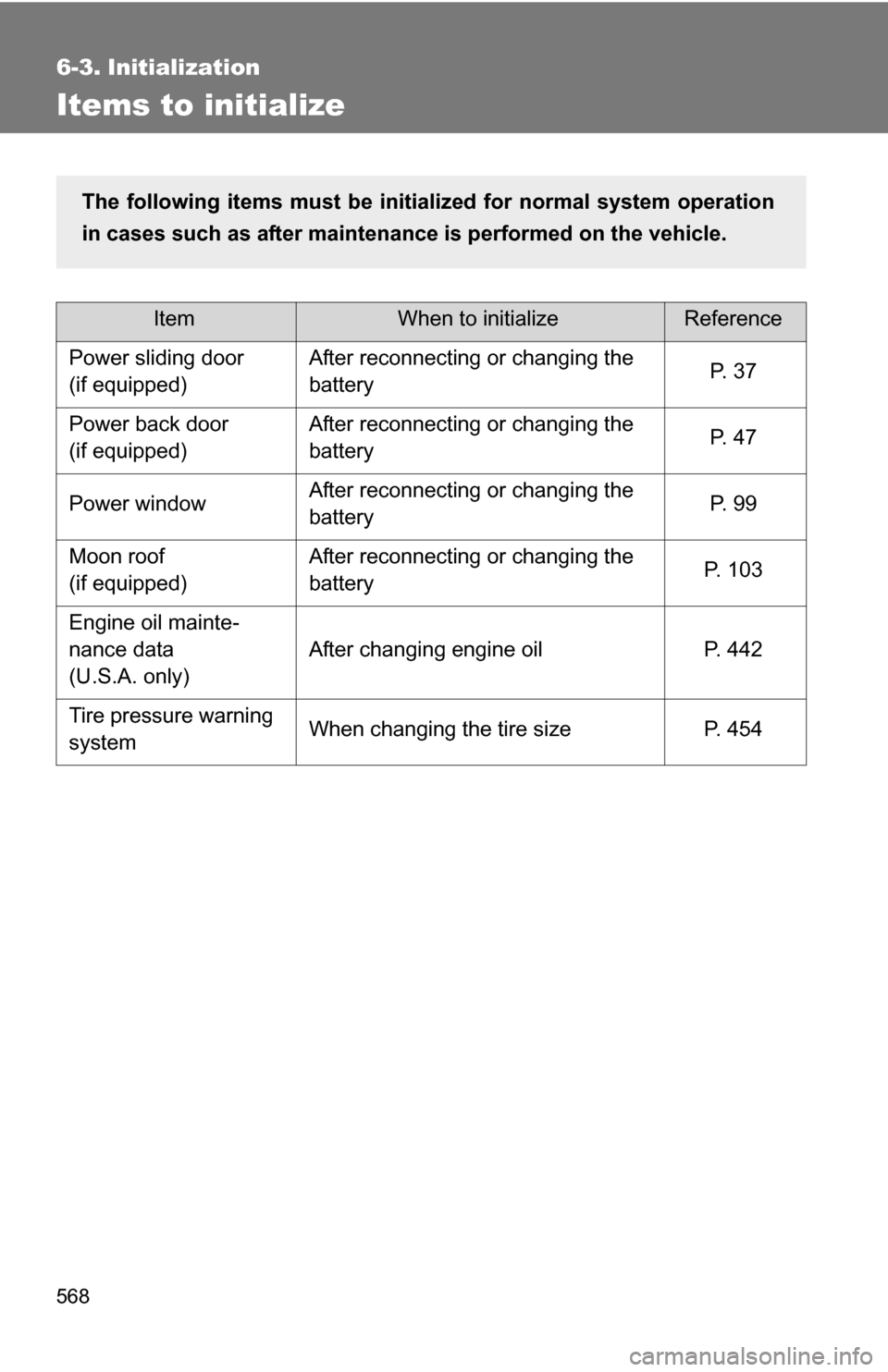
568
6-3. Initialization
Items to initialize
ItemWhen to initializeReference
Power sliding door
(if equipped) After reconnecting or changing the
battery
P. 3 7
Power back door
(if equipped) After reconnecting or changing the
battery
P. 4 7
Power window After reconnecting or changing the
battery P. 9 9
Moon roof
(if equipped) After reconnecting or changing the
battery
P. 103
Engine oil mainte-
nance data
(U.S.A. only) After changing engine oil P. 442
Tire pressure warning
system When changing the tire size P. 454
The following items must be initia
lized for normal system operation
in cases such as after maintenance is performed on the vehicle.
Page 576 of 592

576
Abbreviation list
Abbreviation/Acronym list
ABBREVIATIONSMEANING
2WD 2 Wheel Drive
AWD All Wheel Drive ABS Anti-lock Brake System
ACC Accessory ALR Automatic Locking Retractor
AVG Average
CAL Calibration
CRS Child Restraint System
ECU Electronic Control Unit
EDR Event Data Recorder ELR Emergency Locking RetractorE/M English/U.S. customary system/Metric
GAWR Gross Axle Weight Rating
GVWR Gross Vehicle Weight Rating I/M Emission inspection and maintenance
LATCH Lower Anchors and Tethers for Children
LED Light Emitting Diode
MAX Maximum MIN Minimum
MMT Methylcyclopentadienyl Manganese Tricarbonyl
M + S Mud and Snow
MTBE Methyl Tertiary Butyl Ether
OBD On Board DiagnosticsRFT Run-Flat Tire
SRS Supplemental Restraint System
TIN Tire Identification Number
TPMS Tire Pressure Warning System
Page 578 of 592
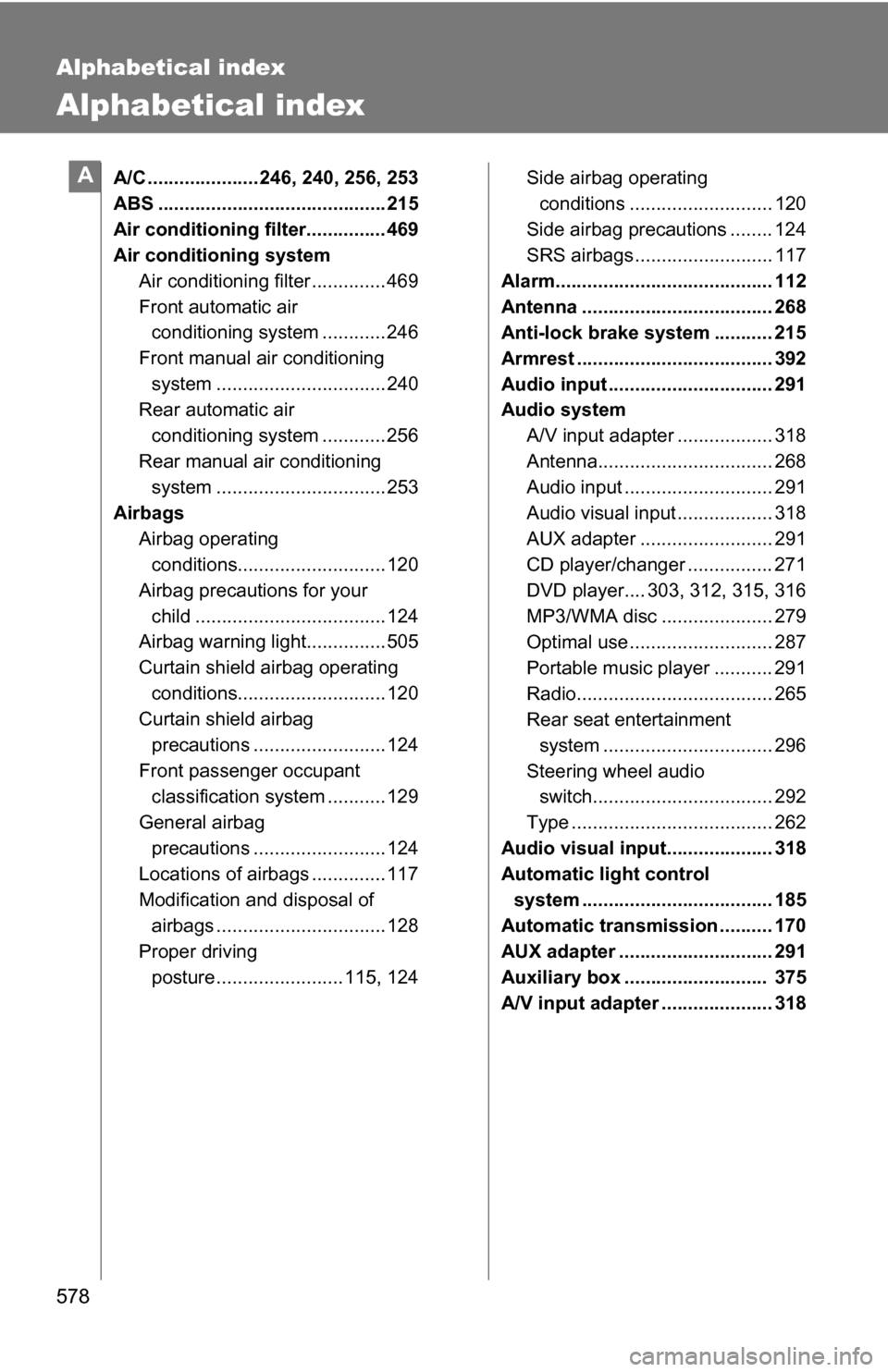
578
Alphabetical index
Alphabetical index
A/C ..................... 246, 240, 256, 253
ABS ........................................... 215
Air conditioning filter............... 469
Air conditioning systemAir conditioning filter .............. 469
Front automatic air conditioning system ............ 246
Front manual air conditioning system ................................ 240
Rear automatic air
conditioning system ............ 256
Rear manual air conditioning system ................................ 253
Airbags Airbag operating conditions............................ 120
Airbag precautions for your child .................................... 124
Airbag warning light............... 505
Curtain shield airbag operating
conditions............................ 120
Curtain shield airbag
precautions ......................... 124
Front passenger occupant classification system ........... 129
General airbag precautions ......................... 124
Locations of airbags .............. 117
Modification and disposal of
airbags ................................ 128
Proper driving
posture ........................ 115, 124 Side airbag operating
conditions ........................... 120
Side airbag precautions ........ 124
SRS airbags .......................... 117
Alarm......................................... 112
Antenna .................................... 268
Anti-lock brake system ........... 215
Armrest ..................................... 392
Audio input ............................... 291
Audio system A/V input adapter .................. 318
Antenna................................. 268
Audio input ............................ 291
Audio visual input .................. 318
AUX adapter ......................... 291
CD player/changer ................ 271
DVD player.... 303, 312, 315, 316
MP3/WMA disc ..................... 279
Optimal use ........................... 287
Portable music player ........... 291
Radio..................................... 265
Rear seat entertainment system ................................ 296
Steering wheel audio switch.................................. 292
Type ...................................... 262
Audio visual input.................... 318
Automatic light control system .................................... 185
Automatic transmission .......... 170
AUX adapter ............................. 291
Auxiliary box ........................... 375
A/V input adapter ..................... 318A